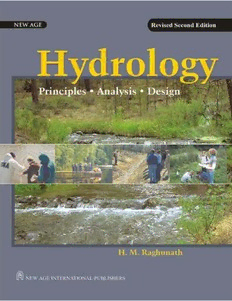Table Of ContentTHIS PAGE IS
BLANK
Copyright © 2006 New Age International (P) Ltd., Publishers
Published by New Age International (P) Ltd., Publishers
All rights reserved.
No part of this ebook may be reproduced in any form, by photostat, microfilm,
xerography, or any other means, or incorporated into any information retrieval
system, electronic or mechanical, without the written permission of the publisher.
All inquiries should be emailed to [email protected]
ISBN (10) : 81-224-2332-9
ISBN (13) : 978-81-224-2332-7
PUBLISHING FOR ONE WORLD
NEW AGE INTERNATIONAL (P) LIMITED, PUBLISHERS
4835/24, Ansari Road, Daryaganj, New Delhi - 110002
Visit us at www.newagepublishers.com
( v )
P S E
REFACE TO THE ECOND DITION
In this new Edition, two more Chapters are included, i.e.,
Chapter 17:Instantaneous Unit Hydrograph (IUH) with Clark and Nash Models illus-
trated with Workedout Examples from field data.
Chapter 18:Cloud Seeding, the technique and operation being profusely illustrated with
actual case histories in India and Russia.
Also, some more illustrative Field Examples are included under Infiltration, Storm Cor-
relation, Gumbel’s and Regional Flood Frequency.
All, with a good print, sketches being neatly redrawn.
Comments are always welcome and will be incorporated in the succeeding editions.
H.M. Raghunath
C—9\N-HYDRO\HYD-TIT.PM5 IV
THIS PAGE IS
BLANK
( vii )
P F E
REFACE TO THE IRST DITION
Hydrology is a long continuing hydroscience and much work done in this field in the past,
particularly in India, was of empirical nature related to development of empirical formulae,
tables and curves for yield and flood of river basins applicable to the particular region in which
they were evolved by investigators like Binnie, Barlow, Beale and Whiting, Strange, Ryves,
Dicken, Inglis, Lacey, Kanwar Sain and Karpov, etc.
In this book, there is a departure from empiricism and the emphasis is on the collection
of data and analysis of the hydrological factors involved and promote hydrological design on
sound principles and understanding of the science, for conservation and utilisation of water
resources. Hydrological designs may be made by deterministic, probabilistic and stochastic ap-
proaches but what is more important is a ‘matured judgement’ to understand and avoid what is
termed as ‘unusual meteorological combination’.
The book is written in a lucid style in the metric system of units and a large number of
hydrological design problems are worked out at the end of each article to illustrate the princi-
ples of analysis and the design procedure. Problems for assignment are given at the end of each
Chapter along with the objective type and intelligence questions. A list of references is included
at the end for supplementary reading. The book is profusely illustrated with sketches and is not
bulky.
The text has been so brought to give confidence and competence for the reader to sit for
a professional examination in the subject or enable him to take up independent field work as a
hydrologist of a River basin or sub-basin.
The text is divided into Fundamental and Advanced topics and Appendices to fit the
semester-hours (duration) and the level at which the course is taught.
Degree and Post-degree students, research scholars and professionals in the fields of
Civil and Agricultural Engineering, Geology and Earth Sciences, find this book useful.
Suggestions for improving the book are always welcome and will be incorporated in the
next edition.
H.M. Raghunath
C—9\N-HYDRO\HYD-TIT.PM5 V
THIS PAGE IS
BLANK
C
ONTENTS
Preface to the Second Edition (v)
Preface to the First Edition (vii)
(cid:1)(cid:2)(cid:3)(cid:4)(cid:5) (cid:2)(cid:6)(cid:7)(cid:8)(cid:9)(cid:10)(cid:2)(cid:11)(cid:12)(cid:9)(cid:4)(cid:2)(cid:13)(cid:5)(cid:14)(cid:15)(cid:10)(cid:3)(cid:16)(cid:13)(cid:16)(cid:17)(cid:15)
1 Introduction 1
1.1 World’s Water Resources 3
1.2 Water Resources of India 3
1.3 Hydrological Study of Tapti Basin (Central India) 5
1.4 Hydrology and Hydrologic Cycle 11
1.5 Forms of Precipitation 13
1.6 Scope of Hydrology 14
1.7 Hydrological Data 14
1.8 Hydrologic Equation 15
2 Precipitation 17
2.1 Types of Precipitation 17
2.2 Measurement of Precipitation 18
2.3 Radars 22
2.4 Rain-gauge Density 22
2.5 Estimates of Missing Data and Adjustment of Records 23
2.6 Mean Areal Depth of Precipitation (P ) 26
ave
2.7 Optimum Rain-gauge Network Design 31
2.8 Depth-Area-Duration (DAD) Curves 33
2.9 Graphical Representation of Rainfall 36
2.10 Analysis of Rainfall Data 38
2.11 Mean and Median 43
2.12 Moving Averages Curve 48
2.13 Design Storm and PMP 49
2.14 Snow Pack and Snow Melt 49
3 Water Losses 60
3.1 Water Losses 60
3.2 Evaporation 60

